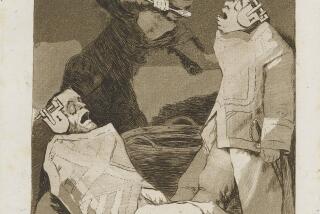Why Kenneth Jarecke’s gruesome war photo needs to be seen

- Share via
The photo shows a man, his skin blackened, his teeth set in a grimace, a barely human figure who was carbonized trying to escape his deathtrap of a burning truck. The man is Iraqi. The setting is the Highway of Death, the strip of road that led north out of Kuwait into southern Iraq, where the allied forces of Gulf War I bombed an Iraqi convoy attempting to retreat.
Snapped by combat photographer Kenneth Jarecke, it has all the makings of an iconic war photograph. But at the time he took it, in the pre-Internet days of 1991, it was barely seen — published in only two newspapers, both in Europe.
The Atlantic has a terrific story about the photo’s history and why it went largely unnoticed in the United States. Be forewarned: the article shows the gruesome image. (Though, to be honest, the image is not that different from some of the scared-straight photos of drunk-driving accidents I was shown as a teen in drivers education.)
Certainly, a general post-Vietnam squeamishness about showing the carnage of war was one reason the photo hasn’t been widely seen. It’s a topic Conor Friedersdorf addressed in an essay last year, also in the Atlantic, and which author Barbie Zelizer addresses in this smart interview in Slate.
It is also, quite simply, a difficult photo to look at, so I can understand why editors wouldn’t want to slap it all over their front pages.
As a viewer, however, I think it’s important not to look away from photographs such as these.
A couple of years back, photography writer Jörg Colberg and I had an online debate about the purpose of showing images of death and violence. Colberg saw little value in it. I disagreed. Although I hardly want the evening news to turn into a nightly celebration of gore, I do think that showing such images reminds us of the human cost of our political and social policies.
Or, as Jarecke wrote in a photography magazine in 1991: “If we’re big enough to fight a war, we should be big enough to look at it.”
I also think there’s something a little weird about a culture that revels in the violence of “Grand Theft Auto” and the blood-spurting, limb-chopping, brain-eating horror of “The Walking Dead” but can’t handle it when a dead guy shows up on the news.
For me, part of the reason for looking is that violence, in all its guises, is something that, like it or not, imbues so much of our cultural production, whether it’s a scene in a contemporary video game or a 17th century painting. And it is worth looking at it in order to understand it.
Go to any museum, and you’ll find art that chronicles bloody battles, rapes and the gory deaths of saints. Think “Walking Dead” is gnarly? Try all the 16th century scenes of martyrdom in Santo Stefano Rotondo in Rome. Or how ‘bout something related to St. John the Baptist? The L.A. County Museum of Art has a 17th -century stained glass from Switzerland that shows John the Baptist about to get his head chopped off and the Metropolitan Museum of Art in New York has a startling 16th century painting of his head resting sleepily on a platter.
The images are gory, but they also address (and raise) questions of power, identity and faith. This is a topic that my colleague, L.A. Times art critic Christopher Knight, wrote about quite eloquently early last year, describing the gruesome power of a crucifixion depicted on 16th century altarpiece by German painter Matthias Grünewald.
“The cruelty and unspeakable anguish in Grünewald’s altar turned the volume up high, but the image had a benign purpose,” he wrote. “This is a violent picture that was meant to console, offering a viewer some comfort.”
And there are the works, of course, that are quite simply devoted to depicting the horrors of war, such as Francisco de Goya’s “Disasters of War” series, and Otto Dix’s horrifying drawings from World War I.
Photography is also part of the artistic canon. Battlefield daguerreotypes from the American Civil War, the first conflict that was widely photographed, have figured prominently in recent exhibitions at the Metropolitan Museum and the Huntington Library. They also reside in the permanent collection of the Getty Museum. More recent conflicts have made their way into the galleries of New York’s International Center of Photography and L.A.’s Annenberg Space.
Photographs, even when they are about war, represent an art. A good photographer doesn’t just randomly snap moments of violence. They analyze light, they choose an angle, they frame and they crop. They present an image as they see it and as they want you to see it.
The burned man in the Iraqi truck tells a story: of the horrors of war, of a human being’s final moments, of a war that seemed clinical on the news but was filled with horrors on the ground. It also chronicles the other-worldliness of war: the blackened figure, bathed in eerie light, like some creature from another planet. Except that creature is us.
Find me on Twitter @cmonstah.
More to Read
The biggest entertainment stories
Get our big stories about Hollywood, film, television, music, arts, culture and more right in your inbox as soon as they publish.
You may occasionally receive promotional content from the Los Angeles Times.











